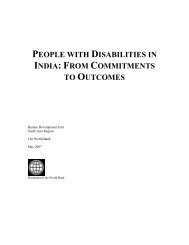FREE Download - TARSHI
FREE Download - TARSHI
FREE Download - TARSHI
You also want an ePaper? Increase the reach of your titles
YUMPU automatically turns print PDFs into web optimized ePapers that Google loves.
sexual coercion. George's (2000) study clearly presents how the interviewers and study participants<br />
were matched by sex, ethnic background and language to facilitate the data collection process.<br />
The class and caste differences between researchers and participants is an aspect that researchers<br />
have not looked into. However, none of the studies (except Chandiramani, 1998) mentions the effects<br />
on the interviewers of having to listen to participants' accounts of pain, violence and oppression.<br />
Sample Groups<br />
Most studies, with a few exceptions (eg. Bhende, 1994), have not adequately described the<br />
characteristics of the study sample. The rationale for selecting a particular group is also absent in a<br />
majority of the studies. Studies based on 'special groups' of truck drivers or sex workers, are an<br />
exception, and the rationale for selecting these groups is based purely on the HIV/AIDS model (Bansal,<br />
1997; Rao et al, 1994). Furthermore, many studies have used samples of convenience, especially<br />
volunteer sample groups. There is, therefore, a likelihood of obtaining biased findings because<br />
a self-selected group is likely to give responses different from those of the general population. Only a<br />
few studies have reflected upon and cautioned readers about this aspect (eg. George, 1998).<br />
Qualitative Methodologies<br />
Selection of participants: Few of the studies reviewed here explained the bases and methods of<br />
selection of the study participants. It is wise when researching a sensitive issue, to begin with participant<br />
groups that researchers are familiar with. Because of the rapport and trust already established,<br />
researchers are likely to obtain responses that are more candid. However, because these participant<br />
groups might not adequately represent a larger population, the findings might be ungeneralisable.<br />
Despite this shortcoming, these initial studies may open the way for those that are more representative<br />
of larger populations. One study that stands out as a good example (DCT, 1997) described the evolving<br />
process of selection of participants: starting with key informants who in turn proposed others, the<br />
researchers also engaged in a social mapping exercise with young men to understand the dynamics of<br />
and groupings in the local community.<br />
Tools: Most of the studies using a qualitative approach used appropriate methods to answer research<br />
questions (e.g., Sodhi's, 2000, study on the dynamics of relationships between boys and girls).<br />
The qualitative studies employed various tools, such as semi-structured one to one interviews, in-depth<br />
interviews, informal interviews, focus group discussions (FGDs), and informal group discussions.<br />
Participatory tools such as self-monitoring cards, mapping, and free listing (1) have also been used.<br />
Direct and participant observations were rarely used. An exception is Evans and Lambert's (1997) study<br />
on the health seeking and sexual health of female sex workers in Calcutta that fruitfully used participant and<br />
direct observation methods in the community and in a clinical set-up respectively. Bhende's study (1994) on<br />
adolescent boys and girls in Bombay also makes imaginative use of observation methods in the community.<br />
Tool development: Some of the qualitative studies have used a systematic procedure of tool<br />
development (eg. Amin et al, 1996; Evans & Lambert, 2000; George, 1998). Appropriate local<br />
terminologies were explored through informal group discussions, and subsequently included in the<br />
interview guidelines or questions (eg. George, 1998). This is a useful strategy to improve the quality of<br />
research tools. Although in most of the studies the tools were translated into the local language, very<br />
few researchers (Joseph et al, 1998) have employed the procedure of back translation (translating from<br />
the translation back to the original language to check for accuracy of translation) of tools to increase the<br />
(1) Freelisting is a list that covers the full domain of terms and concepts that pertain to a specific problem. It is used to determine the items in a cultural<br />
domain, to differentiate between items that are culturally cognizant or salient and those which are not (Gittelsohn et al. 1995).<br />
13










